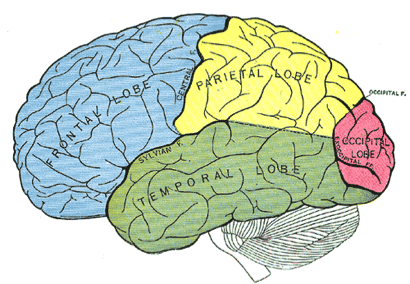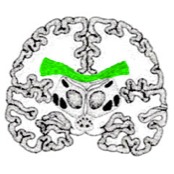The Cerebrum!
This is the soft cloud-like outer area of the brain that is the majority of the brain’s mass. There are two hemispheres that are separate from each other, but are connected by a central bridge called the corpus callosum (see center right). This bridge facilitates the communication and processing between the two hemispheres.
Human brains are uniquely different as faces are uniquely different. We all share common parts with similar functionality, but small physical changes in make significant differences the the outcomes. Apparently, our brains grew in size at a rate that was quicker than skull growth, and therefore our brains have folded over and created more internal space this way. Those folds, or wrinkles, are also unique per person. However, generally speaking, our major folds are usually found the expected places, such as nose and mouth placement on our faces. Those main wrinkles are used to divide the brain up into lobes. Although our brains must often incorporate massively complex networks that span the entire brain, these lobes do mark certain key areas of brain functionality. However, it must be stressed that the current ability in defining key area does not equate full understanding of the brain, nor does it imply that, as several dubious books and corporations capitalize on, some human are ‘more left-brained’ because they display certain attributes. The brain’s networking system is by far the most intricate system humans know of. The massively convoluted system in used in its entirety all day, everyday. Moreover, cognitive outcomes are context dependent—strongly inclusive of the brain’s past cognitive outcomes. Therefore, it is utterly simplistic to expect to be able to single out single regions of the brain as the causative agents of human actions. Our cognitive outcomes range from chaotic to harmonious brain usage but are always a dynamic context-dependent phenomenon.
The Cerebral Cortex (see lower right) is the outermost layer of the cerebrum. It is the most important 'human' part of the brain because it is where our conscious perceptions and thoughts occur.
Human brains are uniquely different as faces are uniquely different. We all share common parts with similar functionality, but small physical changes in make significant differences the the outcomes. Apparently, our brains grew in size at a rate that was quicker than skull growth, and therefore our brains have folded over and created more internal space this way. Those folds, or wrinkles, are also unique per person. However, generally speaking, our major folds are usually found the expected places, such as nose and mouth placement on our faces. Those main wrinkles are used to divide the brain up into lobes. Although our brains must often incorporate massively complex networks that span the entire brain, these lobes do mark certain key areas of brain functionality. However, it must be stressed that the current ability in defining key area does not equate full understanding of the brain, nor does it imply that, as several dubious books and corporations capitalize on, some human are ‘more left-brained’ because they display certain attributes. The brain’s networking system is by far the most intricate system humans know of. The massively convoluted system in used in its entirety all day, everyday. Moreover, cognitive outcomes are context dependent—strongly inclusive of the brain’s past cognitive outcomes. Therefore, it is utterly simplistic to expect to be able to single out single regions of the brain as the causative agents of human actions. Our cognitive outcomes range from chaotic to harmonious brain usage but are always a dynamic context-dependent phenomenon.
The Cerebral Cortex (see lower right) is the outermost layer of the cerebrum. It is the most important 'human' part of the brain because it is where our conscious perceptions and thoughts occur.



